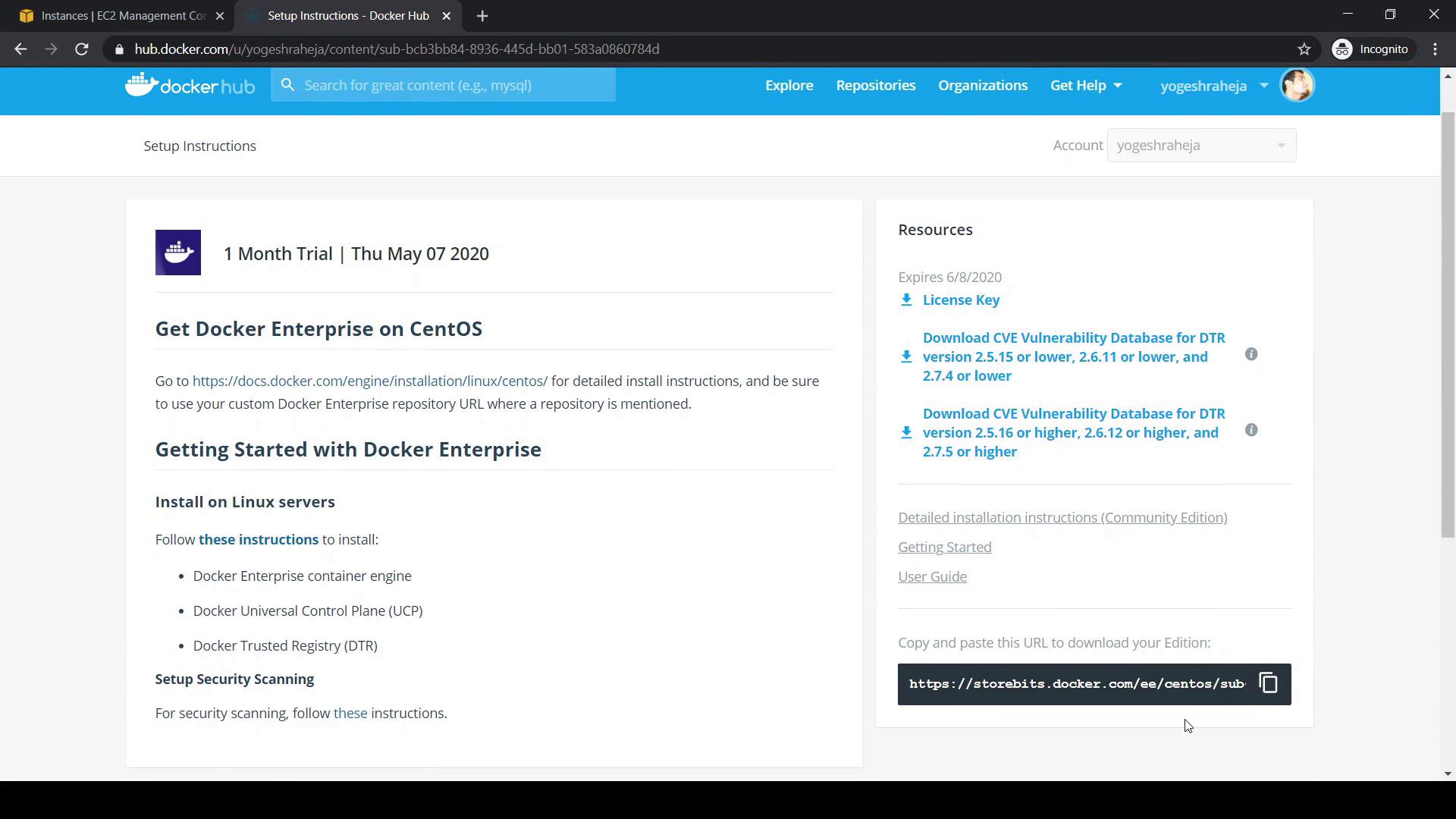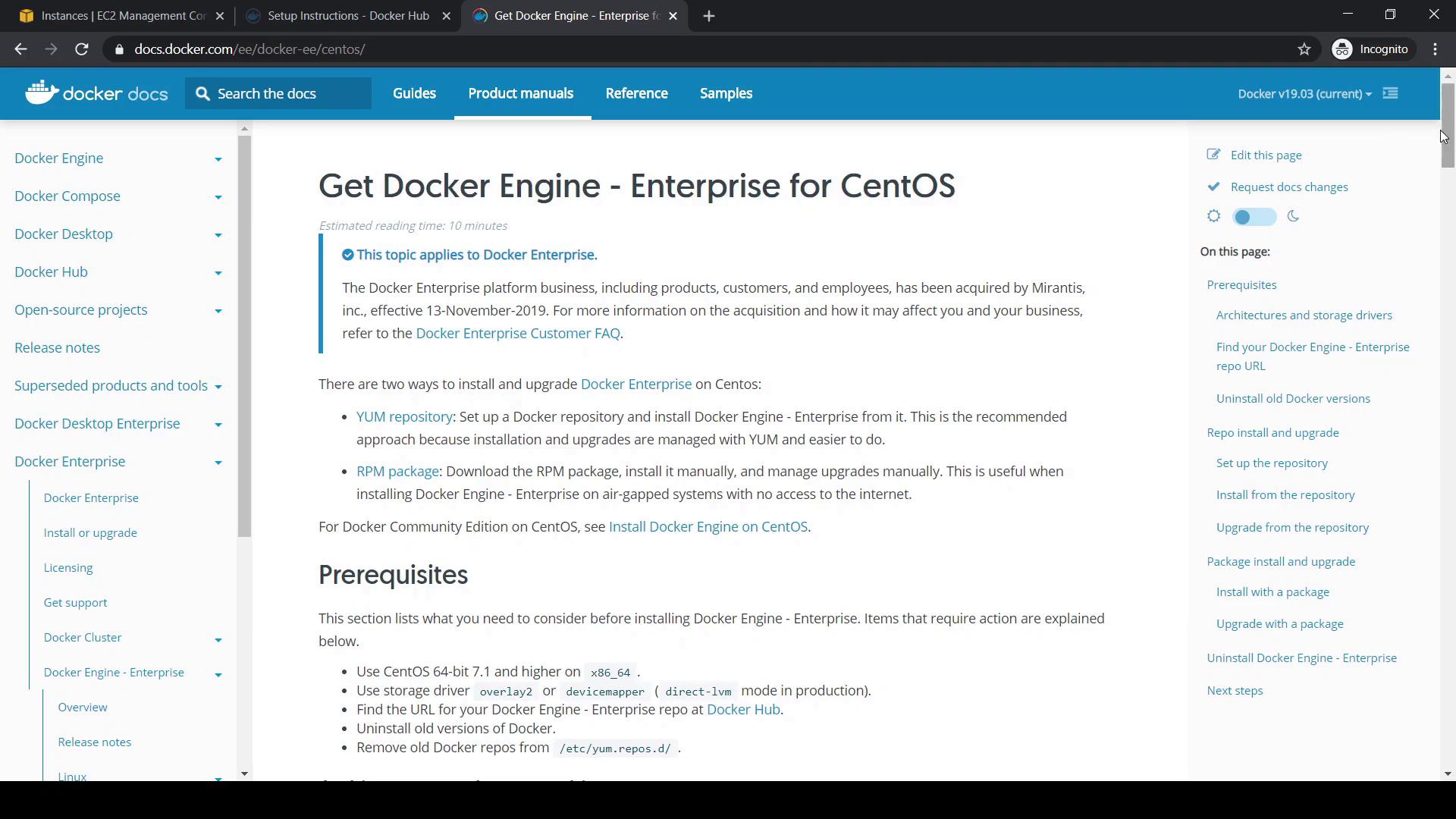Docker Certified Associate Exam Course
Docker Engine Enterprise
Demo Docker EE Setup
In this guide, you will learn how to install Docker Enterprise Edition (EE) on AWS. We cover registering for a 30-day Docker EE trial, installing Docker EE Engine on CentOS 7.6, configuring Universal Control Plane (UCP) and Docker Trusted Registry (DTR), and deploying a sample application with both Swarm and Kubernetes on your UCP cluster.
Architecture and Prerequisites
All three CentOS 7.6 nodes share a flat network, have required ports open, and run NTP for time sync.
| Node | Role | vCPU | RAM | Storage | IP Assignment |
|---|---|---|---|---|---|
| ucp-manager | UCP Manager | 2 | 8 GB | 20 GB | Public + Private |
| ucp-worker | UCP Worker | 2 | 8 GB | 20 GB | Public + Private |
| dtr-node | DTR Node | 4 | 16 GB | 20 GB | Public + Private |
1. Register for Docker EE Trial License
- Sign in to Docker Hub: https://hub.docker.com
- Navigate to Explore → Docker EE → CentOS.
- Under Get Docker Enterprise CentOS, click Start One-Month Trial and submit the form.
- After activation, go to My Content to view your license.
- Click Setup to copy your private Docker EE repository URL.

Note
Ensure your corporate firewall allows access to storebits.docker.com and any other Docker EE endpoints.
2. Review Official Installation Documentation
Visit the Mirantis-hosted docs for Docker EE Engine:
- Go to https://docs.docker.com → Product Manual → Docker Enterprise.
- Select Engine → Linux → CentOS.
You’ll find prerequisites (CentOS 7.1+) and steps to configure the Docker EE Yum repository. Be aware of the Mirantis acquisition announcement effective November 13, 2019.

3. Install Docker EE Engine
Perform these steps on ucp-manager (then repeat on ucp-worker and dtr-node):
3.1 Verify CentOS Version
[root@ucp-manager ~]# cat /etc/centos-release
CentOS Linux release 7.6.1810 (Core)
3.2 Remove Any Older Docker Packages
sudo yum remove -y docker \
docker-client \
docker-client-latest \
docker-common \
docker-latest \
docker-latest-logrotate \
docker-logrotate \
docker-engine || true
3.3 Configure the Docker EE Repository
Export your private repository URL (replace
<your-docker-ee-url>):export DOCKERURL="<your-docker-ee-url>"Store it in Yum variables:
sudo sh -c 'echo "$DOCKERURL/centos" > /etc/yum/vars/dockerurl'Install prerequisites and add the Docker EE repo:
sudo yum install -y yum-utils device-mapper-persistent-data lvm2 sudo -E yum-config-manager \ --add-repo \ "$DOCKERURL/centos/docker-ee.repo"
3.4 Fix $dockerosversion Placeholder (if needed)
If yum repolist returns a $dockerosversion error, edit /etc/yum.repos.d/docker-ee.repo:
[docker-ee-stable]
name=Docker EE Stable - $basearch
baseurl=https://storebits.docker.com/ee/centos/sub-<ID>/centos/7/$basearch/stable
...
Replace $dockerosversion with 7 under [docker-ee-stable], then rerun:
sudo yum repolist
Warning
Editing repository files incorrectly can break package resolution. Always back up the .repo file before making changes.
3.5 Install Docker EE Packages
sudo yum install -y docker-ee docker-ee-cli containerd.io
3.6 Enable and Start Docker
sudo systemctl enable docker
sudo systemctl start docker
sudo systemctl status docker
3.7 Verify the Installation
[root@ucp-manager ~]# docker version
Client: Docker Engine - Enterprise
Version: 19.03.5
...
Server: Docker Engine - Enterprise
Engine:
Version: 19.03.5
...
Congratulations! You have successfully installed Docker EE Engine on CentOS 7.6. Next, you will configure UCP and DTR, add worker nodes, and deploy sample workloads using Swarm and Kubernetes.
Links and References
- Docker EE Trial on Docker Hub
- Docker Enterprise Documentation
- Kubernetes Basics
- Mirantis Acquisition Announcement
Watch Video
Watch video content